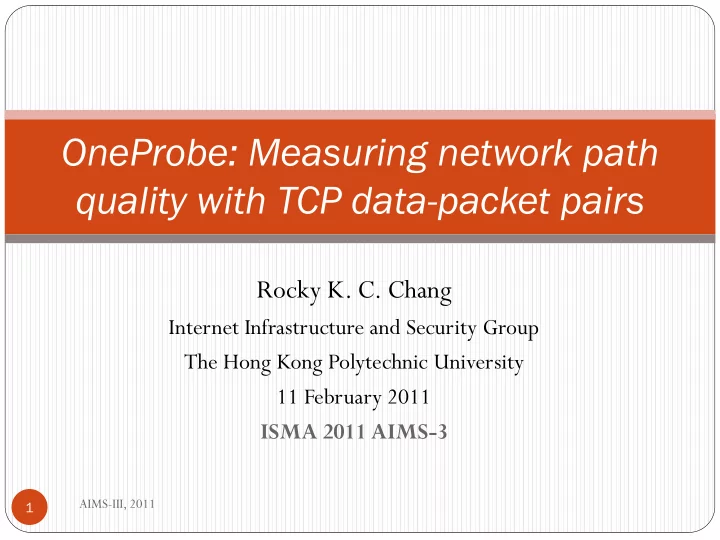

OneProbe: Measuring network path quality with TCP data-packet pairs Rocky K. C. Chang Internet Infrastructure and Security Group The Hong Kong Polytechnic University 11 February 2011 ISMA 2011 AIMS-3 AIMS-III, 2011 1
Our group Active measurement Non-cooperative path-quality measurement methodologies OneProbe (RTT, loss, reordering), capacity measurement, loss-pair measurement, traceroute analysis Applications Longitudinal analysis of network evolution, collaborative diagnosis of routing and performance problems, impact analysis of submarine cable faults, … Activities Publications, research proposals, professional services Work with HARNET, ISPs, data centers, …. Plan to work with other groups, including CERNET in China AIMS-III, 2011 2
Outline 1. Path-quality measurement methodologies 2. Applications Cooperative network measurement (a demo) • An impact analysis of a submarine cable fault • 3. Conclusions and future works AIMS-III, 2011 3
1. Path-quality measurement AIMS-III, 2011 4
Measuring e2e network paths AIMS-III, 2011 5
Active measurement models Controlling both endpoints E.g., one-way delay, OWAMP , TWAMP Controlling one endpoint (non-cooperative measurement) Using/hacking existing protocols E.g., ping, tulip, sting … Controlling zero endpoint E.g., King AIMS-III, 2011 6
Active measurement models Controlling both endpoints E.g., one-way delay, OWAMP , TWAMP Controlling one endpoint (non-cooperative measurement) Using/hacking existing protocols E.g., ping, tulip, sting … Controlling zero endpoint E.g., King AIMS-III, 2011 7
(Invalid) assumptions Control-path quality = data-path quality ICMP , TCP SYN, TCP RST Middleboxes not an issue Dropping, rate-limiting, additional latency No changes in systems Consecutive increment of IPID (e.g., tulip) Sampling rate and pattern not an issue AIMS-III, 2011 8
(Invalid) assumptions Control-path quality = data-path quality ICMP , TCP SYN, TCP RST Middleboxes not an issue Dropping, rate-limiting, additional latency No changes in systems Consecutive increment of IPID (e.g., tulip) Sampling rate and pattern not an issue Invalid assumptions beget unreliable measurement. AIMS-III, 2011 9
Other problems in practice Support only one or two metrics Round-trip measurement No control over packet sizes Not integrated with application protocols AIMS-III, 2011 10
Other problems in practice Support only one or two metrics Round-trip measurement No control over packet sizes Not integrated with application protocols Practical issues stifle deployment. AIMS-III, 2011 11
Our design principles Use normal data packet to measure data-path quality. Use normal and basic data transmission mechanisms Integrated into normal application sessions. AIMS-III, 2011 12
Our design principles Use normal data packet to measure data-path quality. Use normal and basic data transmission mechanisms Integrated into normal application sessions. Reliable measurement AIMS-III, 2011 13
HTTP/OneProbe Use normal TCP data packet to measure data-path quality. Use normal and basic TCP data transmission mechanisms specified in RFC 793. Integrated into normal HTTP application sessions. BitTorrent RTMP HTTP Data … clocking Path OneProbe (TCP) measure- ment AIMS-III, 2011 14
What does HTTP/OneProbe offer? Continuous path monitoring in an HTTP session (stateful measurement) All in one: Reverse Forward Round-trip time Loss Loss Loss rate (uni-directional) Reverse Forward Reordering rate (uni-directional) Reordering Reordering OneProbe Capacity (uni-directional) Loss-pair analysis Forward Reverse … Capacity Capacity RTT "Design and Implementation of TCP Data Probes for Reliable and Metric- Rich Network Path Monitoring,“ Proc. USENIX Annual Tech. Conf. , June 2009. AIMS-III, 2011 15
AIMS-III, 2011 16
AIMS-III, 2011 17
AIMS-III, 2011 18
OneProbe: the probe design Send two back-to-back probe data packets. Capacity measurement Packet reordering Determine which packet is lost. Similarly for the response packets Each probe packet elicits a response packet AIMS-III, 2011 19
OneProbe: Bootstrapping and continuous monitoring AIMS-III, 2011 20
OneProbe: Loss and reordering measurement via response diversity AIMS-III, 2011 21
Discrepancy between ping RTT and OneProbe RTT AIMS-III, 2011 22
Highly asymmetric loss rates AIMS-III, 2011 23
Impact of configuration changes AIMS-III, 2011 24
2.1 Application: Collaborative path- quality measurement AIMS-III, 2011 25
HARNET measurement (since 1 Jan 2009) AIMS-III, 2011 26
Running OneProbe at the 8 Us 24x365 probing of the paths to 40+ websites AIMS-III, 2011 27
User side Measurement side 28 OneProbe@ AIMS-III, 2011 HKU HKU OneProbe@ CUHK CUHK OneProbe@ PolyU PolyU 40+ web servers selected by the JUCC OneProbe@ CityU database, etc CityU Planetopus, OneProbe@ BU BU OneProbe@ HKUST HKUST OneProbe@ LU LU OneProbe@ HKIED HKIED
AIMS-III, 2011 29
2.2 Application: Impact analysis of submarine cable faults AIMS-III, 2011 30
Eyjafjallaj ö ekull volcano eruption AIMS-III, 2011 31
Path-quality degradation for NOK (Finland) and ENG (in UK) AIMS-III, 2011 32
AIMS-III, 2011 33
Network congestion caused by the volcano ashes? The surges on packet loss and RTT occurred on 14 April 2009. But The onsets of the path congestion and air traffic disruption do not entirely match. Some of the peak loss rate and RTT occurred on weekends. Path congestion can still be observed at the end of the measurement period. AIMS-III, 2011 34
A SEA-ME-WE 4 cable fault The SEA-ME-WE 4 cable encountered a shunt fault on the segment between Alexandria and Marseille on 14 April 2010. The repair was started on 25 April 2010, and it took four days to complete. During the repair, the service for the westbound traffic to Europe was not available. "Non- cooperative Diagnosis of Submarine Cable Faults,” Proc. PAM 2011 , March 2011. AIMS-III, 2011 35
The SEA-ME-WE 4 cable AIMS-III, 2011 36
A plausible explanation for the network congestion The congestion in the FLAG network was caused by taking on rerouted traffic from the faulty SEA-ME-WE 4 cable. FLAG does not use the SEA-ME-WE 4 cable for Hong Kong NOKIA, ENG3, and BBC. FLAG uses FEA for Hong Kong NOKIA, ENG3, and BBC TATA uses different cables between Mumbai and London. AIMS-III, 2011 37
Conclusions and current works Turning a network protocol into a measurement protocol. Coming up a novel measurement method is just half a story. Making it work in the non-cooperative Internet is hard. Current works Expanding OneProbe’s capability (e.g., asymmetric available bandwidth) Applications: fault localizations, SLA measurement, speed test, net measurement neutrality, correlating with QoE, … AIMS-III, 2011 38
oneprobe.org AIMS-III, 2011 39
Recommend
More recommend